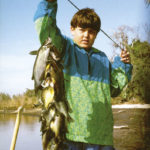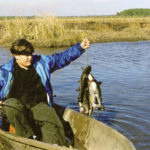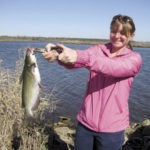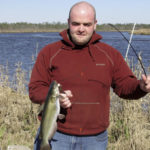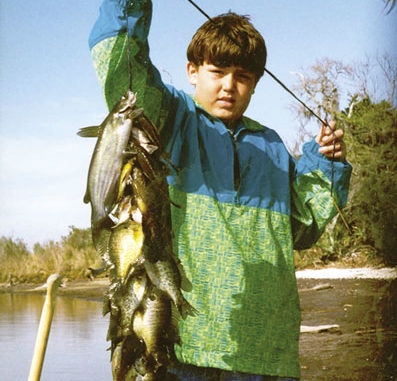
Drown some grass shrimp around Bayou Lacombe’s grass beds this time of year, and you’re liable to catch just about anything.
The kayak was a definite tip-off. The fly rod even more so. Now while Eddie and Pelayo talked him up after we parked behind him on Lacombe’s Lake Road, I nonchalantly slipped around to the back of his Prius to view the obligatory “HOPE” bumper sticker.
Alas, it was missing! But how was he missing one of his fraternity’s most characteristic props? No big deal. Everything else fit perfectly — his looooooong-brimmed cap, like Steve Martin’s as Engineer Dan in “The Jerk,” for instance. His Birkenstock boots. And especially, his utterly atrophied sense of humor.
While parking his Hummer, Eddie had heavily bashed the guy’s Prius — but mostly the (plastic) fender. In the laborious parking process, Eddie also rolled over the guy’s herbal tea and his little tackle box, splattering his cutesy little flies (plus the NON-biodegradable plastic!) all over the road. Now we learned (through a stuttering, sputtering, spittle-spewing rage!) that all had been “homemade!” — and “painstakingly!” so.
Even worse, the fellow’s herbal tea was “a genuinely Zen!” product genuinely imported from some Asian pest-hole whose precise pronunciation was made difficult to understand by the discomfited gentleman’s outraged stutterings and sputterings.
Alas, Eddie was perfectly primed for the task of rebuttal. Indeed, when Eddie picked us up at my house, which had hosted a sleep-over “bachelorette party” (sort of, considering it was her third marriage) held by my darling wife, Pelayo had insisted on snatching Eddie’s keys and driving.
“Mad Dog!” Eddie had yelled as he pulled into my driveway and shoved the bottle out the window for full effect. “Just like Tiger Land! Like for the Alabama game in ‘81!” Eddie’s crazed yelling prompted many of the breakfasting female party-goers onto the porch. “Sure!” Eddie kept raving. “LSU LOST, but WE sure WON — with those TKE little sisters!”
WHAM! At Eddie’s outburst my front door slammed shut behind us. Some of our group had ended up marrying TKE little sisters, you see. Worse, these had not yet partaken of the pitcher of mimosas I so graciously prepared for them between assembling my fishing gear and waiting for Pelayo and Eddie to make their characteristically elegant late entrance.
Upon entering Eddie’s hummer, we noticed that Eddie’s bottle of MD 20/20 was actually sealed shut. Among Eddie’s many talents is a facility for spectacularly obnoxious behavior while cold sober. Most people would require half a bottle of Black Jack to achieve such a level of “colorfulness.”
At any rate, Pelayo had (idiotically) returned Eddie’s truck keys for the parking process on Lake Road, knowing full well that parallel parking — especially with a boat trailer — was not among Eddie’s major talents.
And here were the results.
“Look at this!” the flyfisherperson now shrieked while waving the remnants of his smashed tackle box in front of Eddie’s face. “Do you have any idea of the work involved in tying a spoon fly? Or a crab fly?”
Eddie had now opened the Mad Dog. So I cringed while anticipating his response, which though it came at a decibel level to shame The Who’s Warehouse (or even Super Bowl) concert, decorum prohibits my mentioning details in a publication meant for family reading at the domestic hearth.
We ended up pitching in $10 apiece to finally rid ourselves of the prissy little twit.
“Panfishing central” we call Bayou Lacombe and its adjacent lakeshore cuts, ponds and lagoons. For reliability in producing the makings of a fish fry, few (early) spring fishing spots can match it — and none that I know along the North Shore. First off, it’s a bona-fide “bayou” among rivers.
The East, Middle and West Pearl rivers all lie to its east. The Tchefuncte, Bogue Falaya, Bogue Chitto, Tangipahoa, Blood, Tickfaw and Amite rivers all lie to its west. These rivers typically originate much farther north than Bayou Lacombe, and drain a larger amount of land, especially the Pearl. This means they’re much more prone to flood stages in the spring, hence turbidity, hence lousy fishing. I shouldn’t say “lousy,” more like “undependable.” Any downpour north of us renders the water high and murky.
But Bayou Lacombe is a mere trickle just north of I-12. It’s a relatively short, sluggish stream. So the panfish turn on here at about the same time as they do in the other short sluggish streams (bayous) south and west of Lake Pontchartrain — places like Pier 90, Des Allemands, the 51 Canal and Manchac.
In my experience, the best panfishing in the Pearl River system peaks in June, when the water’s finally down, clearing up and warming up. That’s when the bluegill, lakerunners, cats and yellow bass go into their feeding frenzies. The Tchefuncte, Bogue Chitto and Tangipahoa turn on a little earlier, mid to late May, at least in my experience. Not that you won’t catch good numbers of panfish a little earlier and a little later. It’s just that they’re more predictable in early summer.
Bayou Lacombe “turns on” much earlier. Also, the variety of fish has a lot to do with Bayou Lacombe’s predictability. Lakerunners, bluegill, yellow bass, white bass, green trout, channel cats, blue cats, goggle eye, the odd sheepshead or redfish — if one species isn’t “turned on” or “running,” a couple of the others always take up the slack.
Lakerunners and bluegill down with lockjaw from a water-roiling downpour? No sweat, go a little deeper with shrimp or chicken livers, and mop up on channel cats. The little stripers (yellow bass, technically) haven’t started their “run,” or ended it abruptly? Well, the bluegill might just be starting their spawn, or simply hungry. Lakerunners — technically red-eared sunfish — scarce? Wait until dusk. That’s when the dinner bell always seems to go off for Bayou Lacombe goggleye. They emerge and start hammering your grass shrimp and little crawfish, especially if you cast right to the edge of the grass line, with the bait 3 feet under a little cork.
You can’t go wrong down here in early spring. The marsh section of Bayou Lacombe — the section from the lake to the tree line — yields hefty stringers, baskets, “boxes” or, in the case of many bankfisherfolk, white bucketfuls of any combination of these panfish.
We launched Pelayo’s flatboat at the dandy new back-down ramp built by the feds for access to Big Branch NWR, hung a right, went under the bridge and into a bayou west of Lake Road, which runs toward Goose Point. We found a deep slough that emptied into the bayou, and “beached” the flatboat. Like most of these cuts, it’s fairly shallow at the mouth then drops down to over 6-foot depths as it starts winding into the marsh, especially in the bends.
Pelayo was already threading on two grass shrimp as I baited up with a piece of deceased market shrimp. Say what you want, but day in and day out. month in and month out, there’s no topping grass shrimp for this type of fishing. Oh I know, worms often work as well. Crickets work too. But they don’t yield the variety of fish that grass shrimp entice. I mean, out here you’ll catch bluegill, lakerunners, goggleye, yellow bass, green trout, barfish, catfish and … .
“GEEZUM! Whatcha got!” I blurted.
Pelayo’s cork hadn’t bobbed twice near an eddy when it vanished and his tiny spinning reel started screeching.
“Hope it’s not a choupique!” he grunted.
“Or a gar!” Eddie laughed just as it frothed the surface. Then another spirited run along the bank. Some more bulldog tugging. Now another torpedo run across to the other side.
“Holy moly!” Pelayo roared while tightening his drag. “I can’t stop him!”
No panfish here my friends. Unless you had one helluva pan. The kind they cook jambalaya in for the jambalaya festival maybe. The sucker was brutal, relentless.
“If I didn’t know better,” Eddie started. “I’d say it’s fighting like a … .”
“YEP!” Pelayo yelled. “It’s a redfish! Saw his tail”
“Right!” I snapped. “But choupique have that spot on the tail just like reds.”
“It’s a red, I’m telling you!” he insisted as he tried to gain some line. “It’s fighting just like the ones at Buras. Look at him!”
A red indeed. Nothing huge. Maybe a 3-pounder, but on ultra-light spinning tackle geared for 7-inch fish, it was more than a match.
Like I was saying — variety. You never know what you’ll catch on grass shrimp out here.
I rigged my elaborate jig (a perch hook tipped with deceased shrimp and two split shots 4 feet under a little Styrofoam bobber), and cast to that hole near the slough’s bend.
“Water’s still kinda cold,” I mused. “They’re probably hanging deep.”
Fifteen minutes later, I hadn’t gotten a bite. But Eddie hauled in a yellow bass, a nice channel cat and a chunky lakerunner, making sure to look my way and gloat with every crank of his reel. He’d been casting toward the shallower water — against my advice.
“Watch-OUT!” Pelayo yelled as he reared back on his ultra-light rod. “Another one here!”
“Not another red, huh?” I gasped. “Looks like … .
Indeed, in seconds it was rolling on the surface. Nice channel cat.
“Where’d you cast?” I asked.
“Right over there,” he pointed with his pole.
It was a shallow flat, the kind that form opposite the bends. I cast toward it with my cork adjusted to 2 feet, and quickly latched onto a chunky bluegill. Then they shut off, and we moved down a hundred yards or so to where two big duck ponds drained into the slough. A front two days earlier still had the water plummeting. The ripples from the current almost formed rapids as they converged over the shallow water.
“Cast over there, Eddie,” I instructed while pointing toward the deeper, calmer water.
Something was smacking the water there, maybe barfish smacking shiners. So naturally Eddie made a point of frowning at me and casting his market shrimp-tipped mini-jig in the opposite direction, toward the shallow rapids. His cork hit the water and started racing with the current.
“Look at that,” I said, nodding. “Can’t fish there. Too much current and dirty water.”
Just then Eddie’s cork slowed down and started sinking.
“That ain’t a fish Eddie,” I laughed as Pelayo’s little bobber landed nearby. “That’s the hook snagging on the bottom and current pulling on the cork.”
Indeed. He yanked it out and peeled off some strands of milfoil while Pelayo whooped and set the hook!
“We on ’em!”
His little reel’s drag commenced with the singing. Eddie cast right back into the melee with a grass shrimp, and his cork started the little sinking routine again. This time I kept my mouth shut, which was a good idea because in seconds Eddie was himself setting the hook. The water erupted, and his pole bowed.
“Grass, huh!” Eddie quipped while cocking his head in my direction. “Pretty strong grass! I’ll give it that!”
“And pretty active grass, too!” Pelayo laughed as he grabbed the towel to unhook his channel cat.
A nice wake was plowing toward the deeper water, then he rolled on the surface. Then more of the dogged back-and-forth tugging characteristic of — yep, just then a gorgeous channel cat rolled again on the surface.
“Heck, we’re already close to a fish fry,” Eddie said as he netted his own catfish.
“Yeah,” Pelayo nodded. “Especially if we make catfish po-boys,” which sounded like a definite winnah right about then as I hefted the stringer for him to add his fish and admired the delectable tally so far.
Finally, my little cork plunged. Instantly, the fish hit the surface. Then made a long run. Then rolled on the surface again.
“Man that’s another thing I love about these channel cats,” I whooped while savoring the battle. “They fight nothing like hardheads!”
“More like rat reds,” Pelayo quickly added.
“Or even school specks!” Eddie quickly chimed in.
My fishing podnuhs made excellent points, I thought while netting my cat.
“Here’s half a po-boy right here!” I whooped as the catfish gasped and flopped on the floor of the flatboat.
“Another one here!” yelled Eddie as I strung up my fish. (There’s just something about panfishing that calls for a stringer rather than a “box” — for the principle of the thing.)
We caught a dozen channel cats in the place. None under 2 pounds, none over 4. They hit grass shrimp and the leftover market shrimp we brought along — nice and ripe after a month in the freezer. The water was still fairly cold. So we were kinda surprised. We’d expected more of a lakerunner trip. Catfish are supposed to be deep this time of year. At Pass Manchac, you catch them at 40 and 50 feet this time of year. But the more we thought about it, the more sense it started to make.
The water was still cold in the bayou itself. Those shallow duck ponds warm up quickly under the afternoon sun with no clouds. So the water draining out of them into a deeper cut made a perfect fishing spot. And believe me, tangling with a 4-pound channel cat on light spinning tackle in shallow water beats the heck out of cranking them up from the bottom of Pass Manchac.
Come to think of it, a similar pattern occurs at the Rice Fields in Madisonville every early spring. When the water from the rice fields —which are not really rice anymore but shallow ponds that warm by midday on sunny days — empties into the High Bridge Canal, you mop up on lakerunners and bull bream near the outflow. We’ve seen it time and again. I guess the same principle applies here. But with chunky, tasty, white-fleshed channel cats. And that’s just fine with us.
